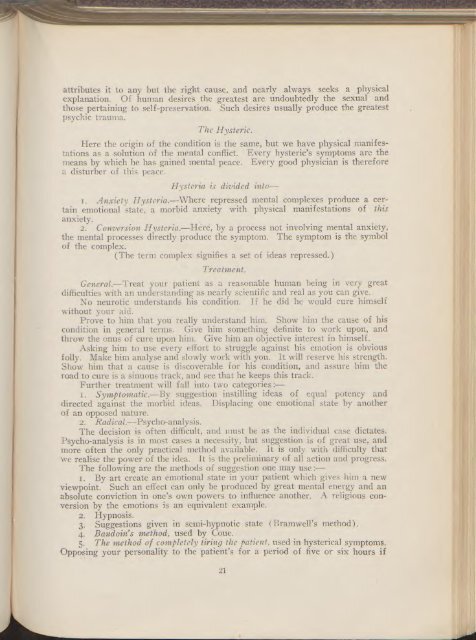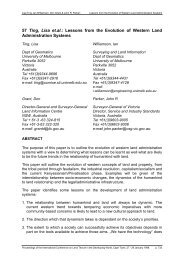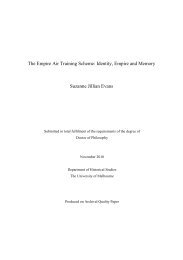ramsay & co.
ramsay & co.
ramsay & co.
You also want an ePaper? Increase the reach of your titles
YUMPU automatically turns print PDFs into web optimized ePapers that Google loves.
attributes it to any but the right cause, and nearly always seeks a physical<br />
explanation. Of human desires the greatest are undoubtedly the sexual and<br />
those pertaining to self-preservation. Such desires usually produce the greatest<br />
psychic trauma.<br />
The Hysteric.<br />
Here the origin of the <strong>co</strong>ndition is the same, but we have physical manifestations<br />
as a solution of the mental <strong>co</strong>nflict. Every hysteric's symptoms are the<br />
means by which he has gained mental peace. Every good physician is therefore<br />
a disturber of this peace.<br />
Hysteria is divided into-<br />
i. Anxiety Hysteria.—Where repressed mental <strong>co</strong>mplexes produce a certain<br />
emotional state, a morbid anxiety with physical manifestations of this<br />
anxiety.<br />
2. Conversion Hysteria.—Here, by a process not involving mental anxiety,<br />
the mental processes directly produce the symptom. The symptom is the symbol<br />
of the <strong>co</strong>mplex.<br />
(The term <strong>co</strong>mplex signifies a set of ideas repressed.)<br />
Treatment.<br />
General.—Treat your patient as a reasonable human being in very great<br />
difficulties with an understanding as nearly scientific and real as you can give.<br />
No neurotic understands his <strong>co</strong>ndition. If he did he would cure himself<br />
without your aid.<br />
Prove to him that you really understand him. Show him the cause of his<br />
<strong>co</strong>ndition in general terms. Give him something definite to work upon, and<br />
throw the onus of cure upon him. Give him an objective interest in himself.<br />
Asking him to use every effort to struggle against his emotion is obvious<br />
folly. Make him analyse and slowly work with you. It will reserve his strength.<br />
Show him that a cause is dis<strong>co</strong>verable for his <strong>co</strong>ndition, and assure him the<br />
road to cure is a sinuous track, and see that he keeps this track.<br />
Further treatment will fall into two categories :—<br />
I. Symptomatic.—By suggestion instilling ideas of equal potency and<br />
directed against the morbid ideas. Displacing one emotional state by another<br />
of an opposed nature.<br />
2. Radical.—Psycho-analysis.<br />
The decision is of ten difficult, and must be as the individual case dictates.<br />
Psycho-analysis is in most cases a necessity, but suggestion is of great use, and<br />
more often the only practical method available. It is only with difficulty that<br />
we realise the power of the idea. It is the preliminary of all action and progress.<br />
The following are the methods of suggestion one may use :-<br />
I. By art create an emotional state in your patient which gives him a new<br />
viewpoint. Such an effect can only be produced by great mental energy and an<br />
absolute <strong>co</strong>nviction in one's own powers to influence another. A religious <strong>co</strong>nversion<br />
by the emotions is an equivalent example.<br />
2. Hypnosis.<br />
3. Suggestions given in semi-hypnotic state (Bramwell's method).<br />
4. Baudoin's method, used by Coue.<br />
5. The method of <strong>co</strong>mpletely tiring the patient, used in hysterical symptoms.<br />
Opposing your personality to the patient's for a period of five or six hours if<br />
21

















